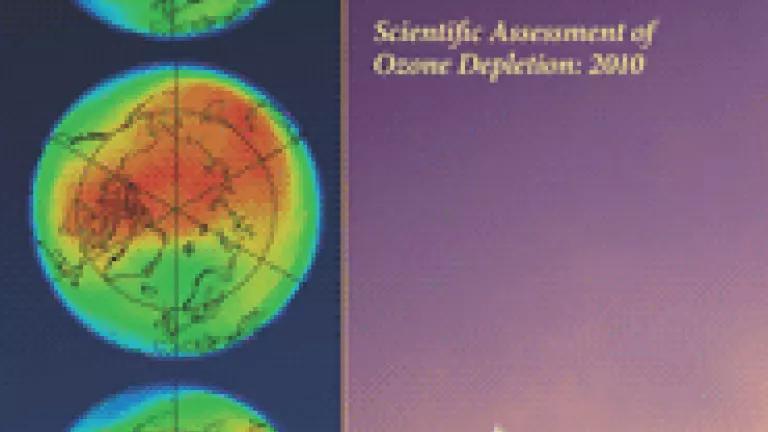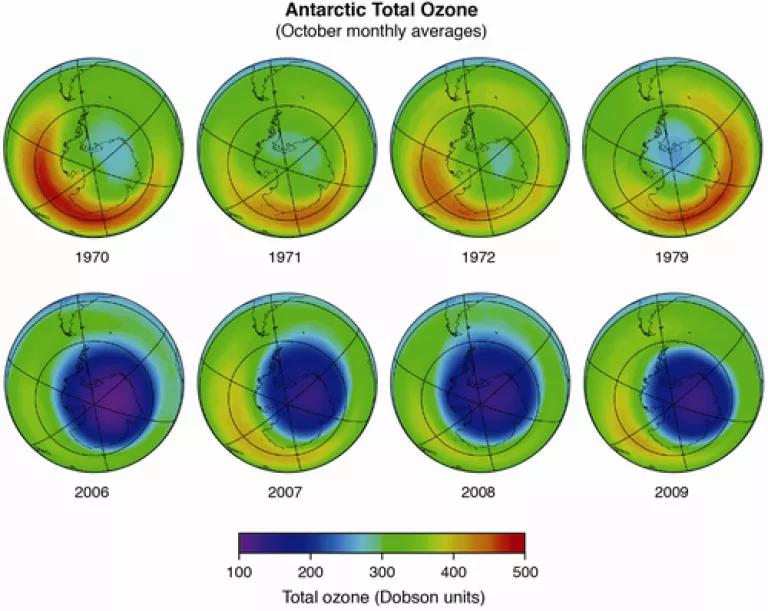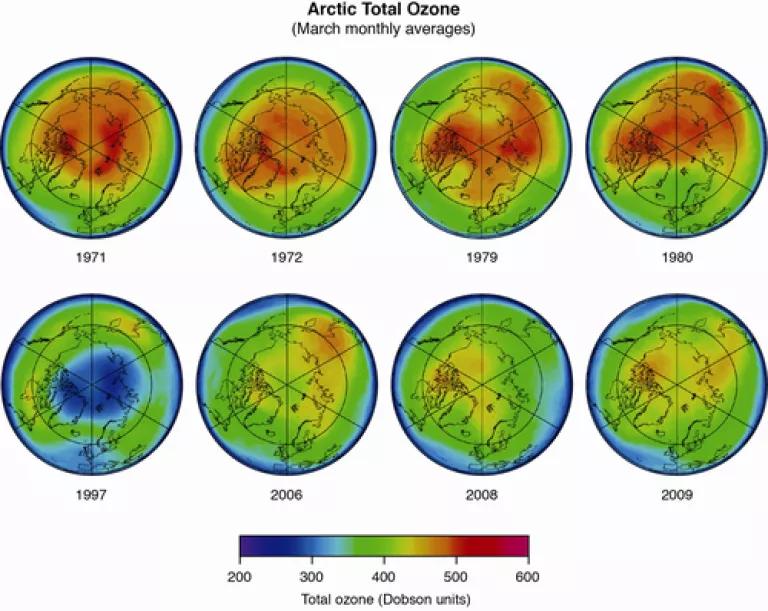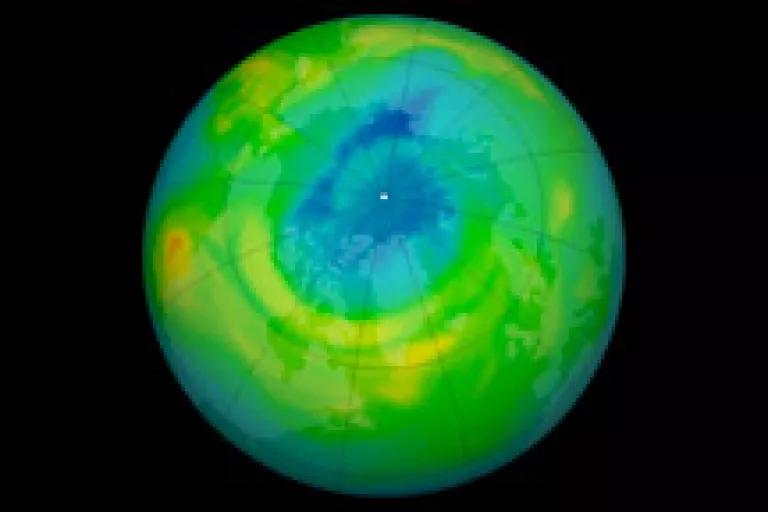
There’s good news and bad news from opposite ends of the earth on the condition of the ozone layer. Overall, these scientific findings show that the ozone layer is starting to recover, thanks to the Montreal Protocol, the treaty responsible for the phasing out chlorofluorocarbons (CFCs) and other ozone-destroying chemicals. But we’re not out of the woods yet.
A thin layer of ozone in the stratosphere protects life on earth by screening out dangerous ultraviolet (UV) radiation from the sun. The ozone layer has been badly damaged by elevated levels of chlorine and bromine in the stratosphere due to man-made CFCs and other ozone-destroying chemicals. As a result, humans are at higher risk of skin cancer, cataracts, and immunological illnesses; animals and plants on land and in the ocean are also endangered.
Showing that we really can come together to solve big problems, more than 40 countries agreed to the Montreal Protocol in 1987. Now, every country on earth belongs to this treaty. Under the treaty (and the Clean Air Act here in the U.S.) we’ve already phased out CFCs and other dangerous chemicals, and many others are being eliminated world-wide over the coming decades. Scientists have long predicted that phasing out these chemicals will let the ozone layer slowly heal. And now there’s evidence that the recovery has begun.
A terrific guide, called “Twenty Questions and Answers About the Ozone Layer,” has just been published by the National Oceanic and Atmospheric Administration (NOAA), the National Aeronautics and Space Administration (NASA), and others. This is a great introduction – for reporters, teachers, students, and others – to the science of ozone depletion, the successful world-wide effort to save the ozone layer, and the connections to climate change. Download the guide here.
Ozone depletion, serious in the “mid-latitudes” where we live, is even worse in the extreme north and south.
The worst depletion takes place over Antarctica. A continent-sized “hole” in the ozone layer has appeared there every September (springtime in the southern hemisphere) since the early 1980s. Special conditions make the impact of ozone-depleting chemicals so severe there: A vortex of super-cold air is trapped over Antarctica every winter. It is so cold there that clouds form in the stratosphere and serve as catalytic surfaces for chemical reactions that free up the most potent ozone-destroying chlorine and bromine compounds. When the sun returns at the end of the long winter, ozone is rapidly destroyed.

This and next image courtesy of NOAA ESRL Chemical Sciences Division, Boulder, Colorado, USA (http://esrl.noaa.gov/csd/)
Fully closing the ozone hole will still take decades, because these long-lived chemicals take so long to leave the air. But if we keep reducing the ozone-depleting chemicals, scientists expect the Antarctic ozone layer to recover after the middle of this century.
What about the other pole? The ozone layer is damaged over the Arctic too, though we don’t usually see the same kind of ozone depletion there as over Antarctica. The reason is that Arctic stratosphere is not as cold, and air doesn’t get trapped as tightly there (think of northern cold fronts spinning south out of Canada). But there are exceptions. 1997 was a bad spring for Arctic ozone. And this spring, the World Meteorological Organization reports, ozone levels over the Arctic dropped 40 percent to record low levels. The Arctic stratosphere was unusually cold this winter – in part because the lower atmosphere over the Arctic was unusually warm. Scientists expect recovery of the Arctic ozone layer between 2020 and 2035. Due to broader climate changes, Arctic ozone concentrations may keep increasing through this century.


Arctic Ozone Loss March 30, 2011, courtesy of NASA’s Earth Observatory
So what is happening between the poles, where most people live? The Twenty Questions guide reports that, comparing average levels from 2005-2009 with average levels from 1964-1980, total ozone levels were down about 3.5 percent in the northern mid-latitudes (35°N-60°N) and down about 6 percent in the southern mid-latitudes (35°S-60°S). That includes all of the United States north of Raleigh, Memphis, Oklahoma City, Amarillo, Albuquerque, and Los Angeles. It includes almost all of Europe, as well as Asia north of Tehran and Tokyo. The ozone layer’s recovery is expected to take until 2030 and 2055 in the northern and southern mid-latitudes, respectively. Ozone levels have been least affected in tropical latitudes (20°N-20°S).
The Twenty Questions guide also explains the important connections between protecting the ozone layer and protecting the climate. The most direct link is that CFCs and many other ozone-depleting chemicals are also powerful greenhouse gases. The Montreal Protocol’s phase-out has produced huge climate benefits as a bonus, equivalent to 11 billion tons of CO2 reductions in 2010 alone. This is more than five times the emission reductions targeted for that year by the Kyoto Protocol, and it’s also equivalent to delaying the growth in global CO2 emissions by 7-12 years.
A second connection is that the stratosphere and the lower atmosphere (the troposphere) are tightly linked. Ozone depletion itself has slightly reduced the total amount of heat trapped in the atmosphere, since ozone itself is a greenhouse gas. But this small negative effect is far outweighed by the heat trapped by CFCs and other greenhouse gases such as carbon dioxide. When greenhouse gases warm the troposphere, the stratosphere gets colder, and that can worsen ozone depletion. There are other complex interactions. For instance, scientists recently reported the Antarctic ozone hole is responsible for changing rainfall patterns across the southern hemisphere.
A third linkage is in the choice of replacements as we phase out the remaining ozone-depleting chemicals. We can replace them in air conditioners, insulating foams and other uses with chemicals that are powerful greenhouse gases (e.g., most hydrofluorocarbons or HFCs). Or we can steer towards chemicals that trap less heat – including various hydrocarbons and newer, less potent members of the HFC family.
The United States, Canada, and Mexico recently renewed a proposal to phase-down the heat-trapping HFCs under the Montreal Protocol. (See here and here.) A similar proposal was relaunched by small island nations led by Micronesia. While these proposals drew the support of 90 countries last year, China and India were not willing to go along, but India and the United States have set up a bilateral task force to study HFC alternatives and options for moving forward. We’ll see if more progress can be made in the Montreal Protocol negotiations this summer and fall.
The bottom line is that the global effort to save the ozone layer under the Montreal Protocol has been one of the world’s best investments in my lifetime. But we’re not finished yet. There’s more to be done under this valuable treaty to protect both the ozone layer and the climate.

